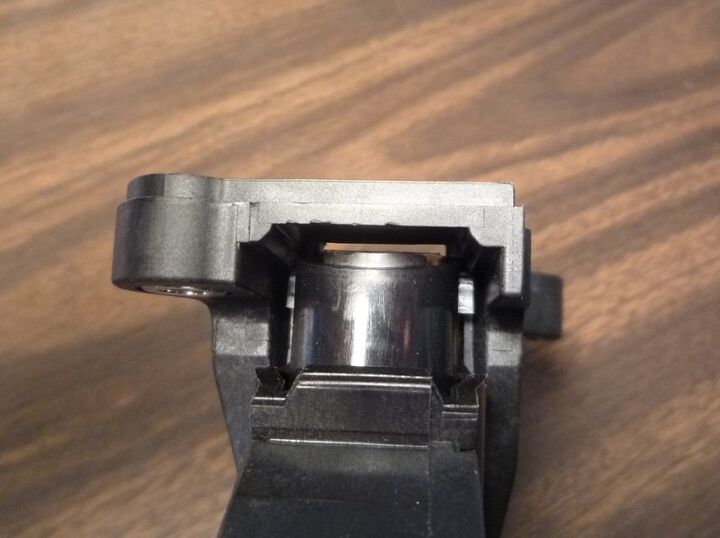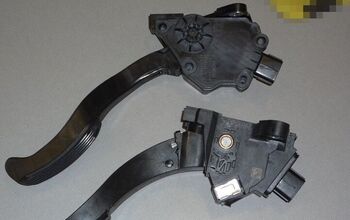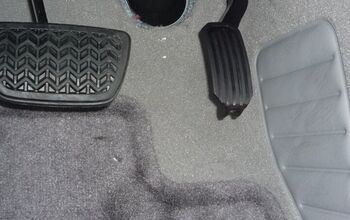Toyota Gas Pedal Fix Simulated: Friction Reduced, But By Too Much?

Update: a portal to all of TTAC’s articles on the subject of Toyota gas pedals is here:
We’ve taken it apart, explained Toyota’s intended fix, and now we’ve replicated the “fix” to see what effect it has. It works, but does it work too well?
In the photo above, the two friction teeth are shown in their operating position before the “fix”. One can easily see their pivot axle sticking out to both sides, in a lighter gray color, just where the friction unit protruded from the housing. The other end of this friction unit is the retainer for the return spring, and this is what creates the pressure on the friction teeth.
The second picture (above) shows the other end of this unit. The round end in the middle of the unit is where the coil spring is retained. The gap as shown in this picture is where the metal spacer would go. It would change the fulcrum angle, and the amount of pressure that the spring would exert on the friction teeth.
In the third picture (above) we have inserted a 1/8″ thick screwdriver shank to simulate a spacer in this area. We don’t know yet what thickness the Toyota space will have, so this is an arbitrary guess to see the effect. The amount of friction was substantially reduced by this increase in the gap, and the change in the fulcrum angle of the friction bar unit. We were not able to actually install the unit in a car to see how it would feel, but the change in feel was very noticeable to the hand.
As we’ve explained in the prior post, the balance of friction to the control spring is what creates a stable, yet safe pedal assembly. By reducing the friction, the pedal will feel “less stable”, and it might be more difficult to maintain a steady throttle opening. The perceived pressure felt by the foot will also be greater. The degree of this affect will of course depend on the thickness of the spacer Toyota specifies.
Undoubtedly, this fix will profoundly reduce the likelihood or possibility of the pedal being stuck or slow to return. But the trade off may not be immaterial. Undoubtedly, Toyota’s intended degree of friction will be compromised by this fix, to one degree or another. And drivers may find the fix unpleasant or uncomfortable, also to some degree or another. Clearly, this fix is a band aid to fix the intrinsic limitations of this design. We will be taking a closer look at the Denso pedal next to see how their design is different.
Update: The final article in this series compares the two pedals (CTS and Denso), and makes a recommendation. Link here.

More by Paul Niedermeyer
Latest Car Reviews
Read moreLatest Product Reviews
Read moreRecent Comments
- El scotto They should be supping with a very, very long spoon.
- El scotto [list=1][*]Please make an EV that's not butt-ugly. Not Jaguar gorgeous but Buick handsome will do.[/*][*] For all the golf cart dudes: A Tesla S in Plaid mode will be the fastest ride you'll ever take.[/*][*]We have actual EV owners posting on here. Just calmly stated facts and real world experience. This always seems to bring out those who would argue math.[/*][/list=1]For some people an EV will never do, too far out in the country, taking trips where an EV will need recharged, etc. If you own a home and can charge overnight an EV makes perfect sense. You're refueling while you're sleeping.My condo association is allowing owners to install chargers. You have to pay all of the owners of the parking spaces the new electric service will cross. Suggested fee is 100$ and the one getting a charger pays all the legal and filing fees. I held out for a bottle of 30 year old single malt.Perhaps high end apartments will feature reserved parking spaces with chargers in the future. Until then non home owners are relying on public charge and one of my neighbors is in IT and he charges at work. It's call a perk.I don't see company owned delivery vehicles that are EV's. The USPS and the smiley boxes should be the 1st to do this. Nor are any of our mega car dealerships doing this and but of course advertising this fact.I think a great many of the EV haters haven't came to the self-actualization that no one really cares what you drive. I can respect and appreciate what you drive but if I was pushed to answer, no I really don't care what you drive. Before everyone goes into umbrage over my last sentence, I still like cars. Especially yours.I have heated tiles in my bathroom and my kitchen. The two places you're most likely to be barefoot. An EV may fall into to the one less thing to mess with for many people.Macallan for those who were wondering.
- EBFlex The way things look in the next 5-10 years no. There are no breakthroughs in battery technology coming, the charging infrastructure is essentially nonexistent, and the price of entry is still way too high.As soon as an EV can meet the bar set by ICE in range, refueling times, and price it will take off.
- Jalop1991 Way to bury the lead. "Toyota to offer two EVs in the states"!
- Jalop1991 I'm sorry, Dave. I'm afraid I can't do that.





































Comments
Join the conversation
Does anyone know if this fix affects accelleration? My 2009 5 speed manual(not fixed) was much quicker than my 2010 5 speed manual.
The 2009 had 28k on it. The 2010 has 1700. The pickup in the higher gears is no way near the old one(which was unfortunately totaled in an accident).